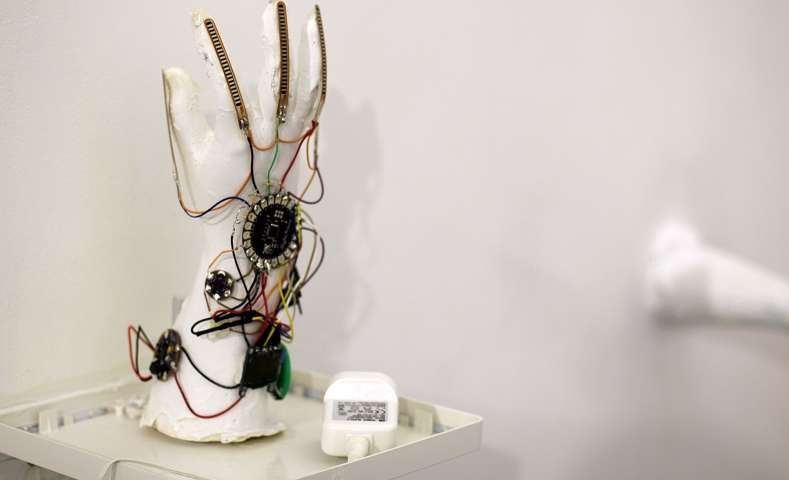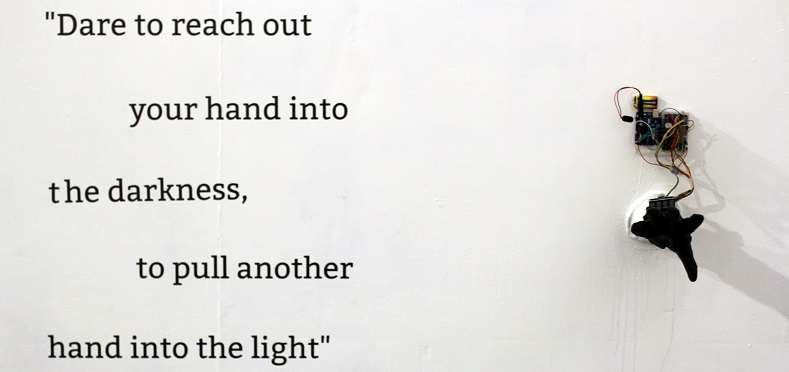A Smart Glove That Converts Sign Language To Speech And Text
There are some inventions that provide you with a thinner and smarter phone and there are some inventions that makes you realize how far we have reached on the curve of advances in technology. Designer and media artist Hadeel Ayoub is a student of University of London and just recently completed her MA in Computational Arts. This young girl has developed a ‘smart glove’ that can convert the sign language into visual text on screen and also into audible dialogue.
Over a period of time, Hadeel developed three prototypes of her glove. Each of those has 5 flex sensors (one on each finger), a microcontroller and an accelerometer. The sensors are useful for detecting curves and bends in the fingers while the purpose of the accelerometer is perceive the orientation of the hand in air. The combined output of the accelerometer and sensors is sent to a serial monitor. Hadeel has also written a program, the algorithm of which uses the output to decide which letters to display on the screen.

The second prototype had a smaller and lighter hardware and also had the feature that allowed to delete the old text on the screen. The third and the latest prototype has the feature of converting the written text into speech. Hadeel said that she is now working on the fourth version that will allow conversion of both the text and the speech into other languages. Also, she wants to develop a version with motion sensor on the glove and a smaller glove for children.

Hadeel says that she doesn’t want to intimidate the users with the wiring and technology. Her main purpose is to develop something that can work anywhere around the world and eliminate barriers between people with visual, speech or hearing impairment. She has already been approached by a number of companies. Her fourth version is expected to cost around 255 euros (Rs 18,500 approx.). Hadeel said that she is hoping that the product is made available on the mass market so that the schools and companies will buy her product and they provide it to the disabled without any cost.
Via: #-Link-Snipped-#
Over a period of time, Hadeel developed three prototypes of her glove. Each of those has 5 flex sensors (one on each finger), a microcontroller and an accelerometer. The sensors are useful for detecting curves and bends in the fingers while the purpose of the accelerometer is perceive the orientation of the hand in air. The combined output of the accelerometer and sensors is sent to a serial monitor. Hadeel has also written a program, the algorithm of which uses the output to decide which letters to display on the screen.

The second prototype had a smaller and lighter hardware and also had the feature that allowed to delete the old text on the screen. The third and the latest prototype has the feature of converting the written text into speech. Hadeel said that she is now working on the fourth version that will allow conversion of both the text and the speech into other languages. Also, she wants to develop a version with motion sensor on the glove and a smaller glove for children.

Hadeel says that she doesn’t want to intimidate the users with the wiring and technology. Her main purpose is to develop something that can work anywhere around the world and eliminate barriers between people with visual, speech or hearing impairment. She has already been approached by a number of companies. Her fourth version is expected to cost around 255 euros (Rs 18,500 approx.). Hadeel said that she is hoping that the product is made available on the mass market so that the schools and companies will buy her product and they provide it to the disabled without any cost.
Via: #-Link-Snipped-#
0
